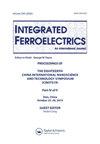Bacterial Cellulose/Titanate Nanotubes Composite Kirigami for Flexible and Stretchable Motion Sensor
IF 0.7
4区 工程技术
Q4 ENGINEERING, ELECTRICAL & ELECTRONIC
引用次数: 0
Abstract
AbstractA composite of bacterial cellulose and titanate nanotubes (BC/TNT) was prepared for use as a stretchable motion sensor in smart and wearable electronics. The composite was characterized using various techniques such as UV-VIS-NIR spectroscopy, SEM, XRD, IR spectroscopy, and thermogravimetric analysis. It was found that the dielectric constant of BC/TNT was up to 2.6 times that of BC with similar loss tangent, indicating improved charge storage. The composite was also constructed into a Kirigami pattern for improved stretchability. With a tensile strain of 0.4%, the change in resistance relative to the original resistance (ΔR/R0) was found to be 5.7% and 6.9% for BC and BC/TNT, respectively, demonstrating improved sensing performance.Keywords: Wearable electronicsflexible sensorbacterial cellulosetitanate nanotubesKirigami Disclosure StatementNo potential conflict of interest was reported by the author(s).Additional informationFundingThis work was financially supported by King Mongkut’s Institute of Technology Ladkrabang (KMITL) under Grant No. KREF116501. Kanokwan Chaithaweep’s work was financially supported by the School of Science, KMITL under Grant No. RA/TA 2565-M-002. We acknowledge the facilities and technical assistance provided by the Nanotechnology and Materials Analytical Instrument Service Unit (NMIS) at the College of Materials Innovation and Technology, KMITL.用于柔性和可拉伸运动传感器的细菌纤维素/钛酸盐纳米管复合基利格米
制备了细菌纤维素与钛酸盐纳米管复合材料(BC/TNT),用于智能和可穿戴电子产品的可拉伸运动传感器。利用紫外可见近红外光谱、扫描电镜、x射线衍射、红外光谱和热重分析等技术对复合材料进行了表征。结果表明,BC/TNT的介电常数可达BC的2.6倍,且损耗相切相似,表明其电荷存储能力有所提高。复合材料也被构造成Kirigami模式,以提高拉伸性。当拉伸应变为0.4%时,BC和BC/TNT的电阻相对于原始电阻(ΔR/R0)的变化分别为5.7%和6.9%,显示出更高的传感性能。关键词:可穿戴电子产品;柔性传感器;细菌;纤维素;本研究由蒙古库特国王理工学院(KMITL)资助,批准号:KREF116501。Kanokwan Chaithaweep的工作得到了KMITL科学学院的财政支持。RA 2565 - m - 002 /助教。我们感谢KMITL材料创新与技术学院纳米技术和材料分析仪器服务部(NMIS)提供的设施和技术援助。
本文章由计算机程序翻译,如有差异,请以英文原文为准。
求助全文
约1分钟内获得全文
求助全文
来源期刊

Integrated Ferroelectrics
工程技术-工程:电子与电气
CiteScore
1.40
自引率
0.00%
发文量
179
审稿时长
3 months
期刊介绍:
Integrated Ferroelectrics provides an international, interdisciplinary forum for electronic engineers and physicists as well as process and systems engineers, ceramicists, and chemists who are involved in research, design, development, manufacturing and utilization of integrated ferroelectric devices. Such devices unite ferroelectric films and semiconductor integrated circuit chips. The result is a new family of electronic devices, which combine the unique nonvolatile memory, pyroelectric, piezoelectric, photorefractive, radiation-hard, acoustic and/or dielectric properties of ferroelectric materials with the dynamic memory, logic and/or amplification properties and miniaturization and low-cost advantages of semiconductor i.c. technology.
 求助内容:
求助内容: 应助结果提醒方式:
应助结果提醒方式:


